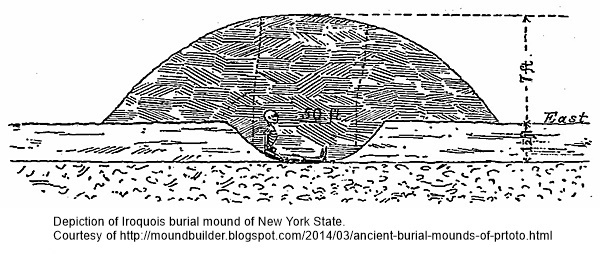
Welcome to Hemlock and Canadice Lakes!
Barns Businesses Cemeteries Churches Clinton & Sullivan Columns Communities Documents Events Time Line Fairs & Festivals Farm & Garden Hiking Homesteads Lake Cottages Lake Scenes Landscapes Library News Articles Old Maps Old Roads & Bridges Organizations People Photo Gallery Podcasts Railroad Reservoir Schools State Forest Veterans Videos
|
News Article |
|
|
Skeletons Found at Hemlock Lake Seven Skeletons Excavated in Man’s Backyard From the Livonia Gazette, 27 June 1879. Rediscovered by Lore Disalvo. 1 Depiction of an Iroquois Burial Mound. Back of the house of Min’ Bugabee, a man well known at Hemlock Lake, which house is situated just across the creek bridge at Gullburg, has been for a longer period than the “oldest inhabitant” can recollect, a peculiar-shaped mound, any where from four to five rods in length. Until recently this mound has never been disturbed, the owners of the place never having suspected that there was anything mysterious connected with it. But yesterday the man who now occupies the place brought out his horses and scraper and proceeded to level it with the rest of the yard. At the depth of about four feet the plow struck against something hard, which upon examination proved to be the thigh-bone of a human person. Now deeply interested the man proceeded to make further investigation, and after considerable digging he brought to the surface seven human skeletons, the skulls and other parts being nearly entire. There is no other way for accounting for their presence by the people who have been there longest, unless it be that they are some of the relics of the Sullivan campaign, as it is evident from their condition that they have been there over a half-century. Part of the bones were lodged under the roots of an old hickory tree, from ten to twelve inches in diameter.
|
||
|
Ancient Burial Mounds of the Iroquois Indians of New York The Proto-Iroquois Indians were the northern contingent of the Adena Hopewell empire that stretched from New York to Florida. The “Hopewell” were a confederation of Iroquois in the Great Lakes, Sioux in the Ohio Valley and Cherokee in the Southeast. Burials in a sitting position are found most commonly in the Great Lakes region. According to Mr. Lewis H. Morgan, different customs had prevailed among the Iroquois in relation to the mode of burial. At one period they buried the dead in a sitting posture, with the face to the east. Skeletons are still found in this position, in various parts of the State of New York, with a gun-barrel resting against the shoulder, thus fixing the period of their sepulture subsequently to the first intercourse of this people with the whites. Another and more extraordinary mode of burial prevailed among them. The body of the deceased was exposed upon a bark scaffolding, erected upon poles or secured upon the limbs of trees, where it was left “to waste to a skeleton”. After this had been effected by the process of decomposition in the open air, the bones were removed either to the former home of the deceased or to a small bark house by its side prepared for their reception. In this manner the skeletons of the whole family were preserved from generation to generation by the affection of the living. After the lapse of a number of years, or in a season of “public insecurity”, or on the eve of abandoning a settlement, it was customary to collect these skeletons from the whole community around, and to consign them to a common resting-place. To this custom, which was not confined to the Iroquois, are, doubtless, to be ascribed the barrows and bone mounds which have been found in such numbers in various parts of the country. On opening these mounds the skeletons are usually found arranged in horizontal layers constituting a conical pyramid, those in each layer radiating from a common centre.
|
